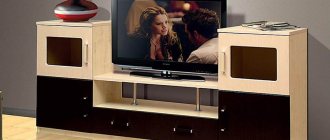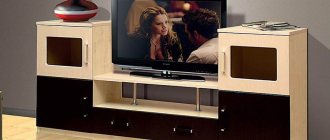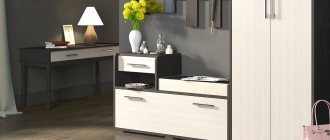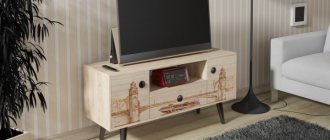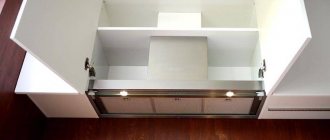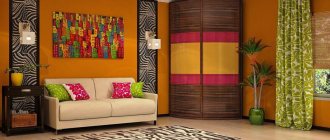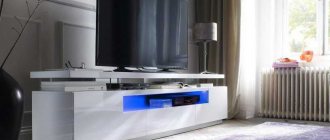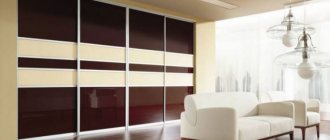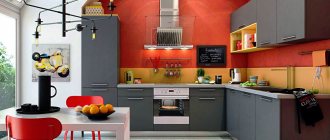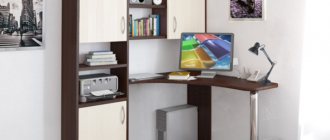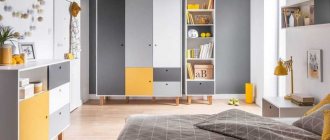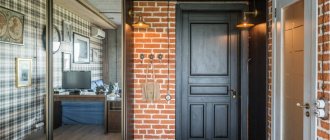<
>
Installing a TV stand in the living room is a fairly classic solution, provided for by most styles. This option will look equally organic in a spacious hall or a small room with a modest footage.
TV stand - advantages
Cabinets are fairly wide cabinets for storing things. However, they are not very tall. TV stands are no exception.
Installing such a piece of furniture provides a number of advantages:
- Pairs well with all types of modern TVs. At the same time, technology remains the dominant element. A correctly selected model will only emphasize its advantages;
- Effective use of footage. This is the most compact piece of furniture traditionally used for living rooms;
<
>
- A wide range of models in any style. You can equally well find a suitable option for a classic setting or with a focus on modern styles;
- Wide range of materials used, including the latest developments;
- Limitless possibilities in terms of decoration;
- A complete storage system with compact dimensions. An ideal solution for homeowners with modest dimensions.
No. 4. Payload
Don’t want your TV to collapse and break a couple of days after installing it on the cabinet? Then when choosing a bedside table, it is imperative to take into account the load that the furniture can withstand. Do not rush to blame manufacturers for making low-quality products. Each of us loads the bedside table differently - you won’t find a universal product, and taking a bedside table with a huge margin of safety means dooming yourself to constant contemplation of a bulky, massive object, the potential of which will not be tapped.
In the description, be sure to find out what load the top shelf or bracket can withstand. Also keep in mind that more than just a TV can be installed on the top shelf, so add up the weight of all equipment, accessories and other items. Don’t forget to add a margin, and if there are kids in the house who are just discovering the world and love to hang on home furniture, then the margin of safety should be maximum.
TV stand frame - design, materials, coatings
The frame of a TV stand is the frame formed after the main parts are assembled. Comprises:
- Sidewalls (standard 2 pieces);
- The upper horizon, which can serve as a functional shelf for the cabinets;
- Lower horizon;
- Rear wall.
The quality and rigidity of the connection of all elements affects the stability of the furniture. Made from the following types of materials:
- Natural wood;
- Wood or particle boards (MDF, chipboard, fiberboard);
- Lacquered coated boards (chipboard, LMDF);
- Plastic;
- Thick tempered glass;
- Synthetic analogues of glass;
- Metals. Rarely used on their own. Most often they are combined with glass, mirrors, and wood.
Many materials require an additional protective layer. For these purposes the following is used:
- Painting with enamels;
- Multilayer varnishing;
- Polymerization (plastic coating);
- Lamination (thermally fixed film).
Shapes and sizes of modern TV stands
When choosing a TV stand, you should take into account the variety of their shapes:
- Geometrically correct. The most used type for floor cabinets;
- Round. Shelves can be elongated or semicircular. Most often, only the front side is rounded, and the back is shaped with an even cut. This makes it easier to position against a wall;
- Shelf type. The traditional case is practically absent. Sometimes all that remains is a narrow vertical bar at the back. Many open shelves are held together using corner posts. A characteristic type for glass structures;
- Complex bookcase. The shelves are not solid at all levels. Some tiers are made from 2 or 3 island shelves with smaller dimensions. In this case, additional steel stops are added;
- Asymmetrical multi-level. Several sections are held together by open long shelves. At the same time, they move sideways. Each section has its own body. A common type for mounted options.
For proper use with the ability to fit a TV stand into the interior, the following dimensions are important:
- Wide. These are considered models with a length of at least 1.2 meters. The largest models reach 3 meters in length. They differ in relatively small parameters in height and depth. Both of these values will fluctuate between 40 – 50 cm;
- Tall. The width starts from 80 cm and is limited to 120 cm. The optimal parameter for height is 85 – 90 cm. Depth rarely exceeds 50 cm;
- Narrow. This is a category from 60 to 80 cm. Using stands with a width of less than 60 cm is dangerous for the TV and the owner. They usually have a low depth parameter. It ranges from 35 to 45 cm. The height can be any, but the average becomes 80 cm;
- Low. This is a traditional option for hanging models. Their height can vary between 30 – 35 cm. The depth is about 40 cm. This is the minimum value. Cabinets with a shallower depth create a risk of the screen installed on it falling. Moreover, such models usually have considerable width (at least 1.4 meters).
Kinds
There are several types of TV stands.
With bracket
A characteristic feature of this option is the presence of a tilt-and-swivel bracket. It is this element that helps change the viewing angle of the screen. Another advantage of such a cabinet is that there is no need to drill into the wall to install it.
A cabinet with a bracket is a metal body standing on wheels, decorated with glass or wood.
It is convenient to move a cabinet with a bracket around the room, choosing a place to watch TV
Hanging
Hanging views will be a solution to the problem of limited space in the room
The suspended structure for the TV is fixed on the wall at the desired height. The hanging option looks like a long decorative shelf that not only holds the TV, but also decorates the interior.
Additionally, the hanging option is used as a storage place for souvenirs and decorative interior items.
Hanging bedside tables cannot be hung on plasterboard walls.
With a chest of drawers
A cabinet with a chest of drawers is functional furniture, on the tabletop of which a TV is placed, and in the internal drawers and cabinets there are discs, books, and newspapers.
Modern models of cabinets with chests of drawers are complemented by side consoles, in which it is convenient to place speakers or books
Corner
Corner option is suitable for a small room
A corner bedside table can be of different shapes: triangle, oval, polygon, the main thing is that the depth of the bedside table does not exceed fifty centimeters. Otherwise it looks bulky.
Corner options can intelligently take up space in an unused corner
Varieties of designs according to placement method
There are the following types of installation of TV stands:
- Floor-standing. The bedside table is installed along the wall directly on the floor;
- Hanging. Creates the effect of “hovering” in the air. Attached to the wall.
The main element of support is the legs. The stability of the entire structure depends on their quality. May be as follows:
- Legs. 4 straight or curved supports attached to the outer corners of the body. All unevenness in the floor is responded to by shakyness and swaying of the furniture;
- Stops. Metal support elements located at an angle to the bottom of the housing. It looks as if the legs have sagged under the weight of the furniture. Very stable option with a high degree of reliability;
- Regulated. These are special screws with several wide, flat washers. By twisting them, the legs can be made of different heights. Very comfortable on uneven floors. Without screed repair work, the furniture will stand level. Not very beautiful in terms of design;
- Base system. Sidewalls extended by several cm act as legs. A transverse narrow strip is added along the front side - a plinth. Acts as a front stop. Allows you to cut corners on the sidewalls when fitting to the baseboard. The optimal width is 7 cm. Narrower bases will ripple when attached. Under it you can hide the not-so-pretty adjustable screws;
- Rollers. They are equipped with a protective decorative casing and a system of stops against arbitrary rolling. Significantly increase the mobility of long cabinets placed on the floor.
For wall-mounted TV stands, the quality of the fasteners comes first. Not so long ago, the choice was limited to several types of anchor bolts. Now in stores you can find up to a dozen types of special furniture canopies. They are distinguished by high resistance to loads. Can withstand at least 120 kg. Designed specifically for hanging the lower tiers of furniture sets. They consist of 2 plates, movably fastened using special bolts. Equipped with additional end caps. Fastened with 4 self-tapping screws. After installation, the cabinet can be moved up or forward by distances of up to 2 - 2.5 cm.
Canopies should always be installed in pairs along the edges. Installing one fastening in the center may result in damage to the furniture body due to improper load distribution. Wide cabinets will warp like scales. In very long versions (over 2 meters), additional fastenings are added in the center.
Style
In order for this piece of furniture to fit perfectly into the interior, it must match the overall style of the room. Modern TV stands differ in size, material, shape, and decor.
- For a room decorated in a classic style, solid wood TV stands are more suitable. They look large, but always provide everything necessary to accommodate equipment. These models are spacious and have an elegant design. They often resemble a chest of drawers in appearance and can be supplemented with side shelves with closing doors.
- High-tech is a more modern style. Glass cabinets with shiny steel fittings are suitable for such rooms. The shapes are unusual, the facades are often bizarrely curved.
- Country or rustic style suggests naturalness and simplicity. Simple shaped furniture made from solid wood is suitable here. It is desirable that the shade of the wood be light.
- Furniture for a minimalist interior does not require unnecessary details; often the cabinet is a very simple bookcase or a laconic L-shaped design.
Classic
High tech
Country
Minimalism
TV placement options
There are several ways to place the TV:
- Surface mounted. To do this, the screen must be equipped with a support leg. Ideally it should be rotating. This way you can adjust the angle of rotation;
- On the wall. For small screens, canopies or dowels are suitable. On durable brickwork, it is better to use steel options. For cinder blocks or foam blocks, purchase propylene dowels. But, for all TVs whose diagonal is equal to or exceeds 50 cm, special brackets are used. Many of them provide the ability to extend the screen forward, rotate it sideways, or even rotate it around its axis by 90° in both directions. Such options will of course cost more, but the ease of use and reliability will be at the proper level;
- Pantograph. In this case, the screen can also be moved in height with a significant spread. But, for this, the screen must have special side “handles” (recesses). Equipping with special holders (beam suspension) is also a prerequisite. Otherwise, the entire structure will lose the lion's share of reliability;
- In a niche. There will be difficulties in providing ventilation and cooling. There should be free space behind the screen. Due to overheating, not only plasma panels break prematurely. The LED screen in long overheating mode will respond to you with delamination. Any master can determine this. The TV will simply “fly out” of the warranty, and delaminated screens cannot be repaired.
On the back of the TV there are special places for mounting the bracket. Even TVs with legs have them. Standard bolts are screwed into them as standard. Only use them. Installing your own may result in a warranty denial. Also, the absence of a technician’s mark on mounting the screen on the bracket may cause the device to be excluded from warranty service.
Facades
All TV stands in the living room have several types of facade opening systems:
- Swing. The doors are attached with special hinges to the body. They open outward towards themselves. They will take up a lot of space. Reliable fastening method. Do not open the doors jerkily;
- Folding. The hinges are moved down the sash, and a pair of breakable side holders are added to the sides. When open, they also “eat up” enough space. Open down until the position lock clicks;
- Sliding. The doors are fastened with hinges in pairs. Moves sideways using the top roller. Folds like a book.
Pay maximum attention to decor:
- The widest variety of decorative glass. Matted, milky, patterned, bent. Richest choice;
- Mirrors. Can be colored or tinted. They will make the room visually wider and brighter;
- Hand painted. An original bright spot that will definitely attract attention;
- Photo printing. The design can be applied to all types of materials;
- Veneering. The material is expensive, capricious, but will give your furniture a luxurious appearance.
Decoration methods
The TV stand not only has a functional purpose, but is also part of the overall interior of the room.
Several decor options:
- decorative glass: frosted, milky, curved, with a sandblasted pattern - any of these options will decorate your bedside table. If desired, decorative glass painting can be ordered according to an individual sketch in special workshops;
- mirrors will help visually expand the space of the room;
- hand painting will emphasize the individual style and taste of the owner of the house;
- photo printing is an inexpensive way to create a design for a new cabinet or transform an already finished item into a TV;
- veneering will transform an inexpensive cabinet made from a chipboard panel into a luxurious piece of furniture.
Antique-decorated cabinets look very interesting in any style
Internal filling
A combination of open and closed straight shelves is considered classic for a cabinet. At the same time, drawers of various sizes can be added to the storage system. This cabinet is suitable for arranging decor, magazines, and books. The presence of glass sections for dishes or a mini bar will add not only functionality to the cabinet, but also style. Most models are equipped with through sections (without a back wall) for accompanying equipment or speakers.
Color solutions
The colors of the cabinets are selected taking into account the overall design of the interior. In this regard, the classic options would be designs in black, black and white or white, which create an atmosphere of impeccable classics. The white color of the products is perceived as stylish and laconic, harmoniously combined with various types of wall and floor decoration. Its main advantage is that it is always in fashion, since it fully highlights other shades of the interior, creating a feeling of more space. In most styles, such as minimalism, fusion, it is better to choose models in light colors.
Colored or two-color cabinets add individuality and style to the design. For example, eye-catching products made in red shades will help you decorate a room in a warm, cozy and lively style. Furniture in green tones looks bright. Curbstones in yellow shades help brighten small spaces and create a sense of celebration. Light colors are best chosen for corner products. Products made from natural light wood or plastic are quite suitable here. In this way you can slightly expand the space.
When choosing a cabinet color, it is recommended to consider a number of factors:
- style solution for room interior;
- the general range of furniture units located near the cabinet;
- color scheme of the television receiver housing.
Additional equipment for television stands
Many TV stands are additionally equipped with:
- Turning platform. This is an oval overlay for the top panel. Almost identical in length. It is attached using a special semicircular element. It can tilt at different angles or rotate around its own axis. A good option for corner cabinets or TVs with a fixed leg;
- TV holder. This is a special rack equipped with a bracket with several degrees of freedom. The stand itself can also be height-adjustable. In this case, there is no problem with attaching the bracket to the wall;
- Backlight. Will give additional originality. It is quite easy to equip it yourself. The main thing is not to light up the TV screen.
Recommendations for choosing furniture for TV equipment
What should be the dimensions of a TV stand for your apartment is determined only by you. If it is important for you to use furniture with the widest possible functions, then pay attention to models with additional storage spaces, drawers, and shelves. This will allow you to place in the cabinet not only things related to the film screening area. Thanks to this, you can minimize the amount of other furniture in the room and unload the space without losing functionality.
In a small room, only compact cabinets are appropriate. In length, they can only be a few centimeters longer than the length of your TV display, and in addition to their main function (a stand for equipment), they have only a couple of slots for auxiliary gadgets (video player, speakers, game console) and disks. In a small room, a corner cabinet diagonally from the seating area will allow you to rationally use the space.
If the living room or bedroom area allows, you can choose a long chest of drawers. Its advantage is its spacious storage area. Unlike traditional walls, this cabinet allows you to attach a TV shelf to the height that is convenient for you. And the configuration with only the lower block of storage space does not limit the choice of a TV with any diagonal, since nothing interferes with the height of the equipment.
Rules for placing a TV stand in the interior of a room
When choosing a place for a TV stand, you will have to focus on a number of the following requirements:
- The selected location should offer a high-quality view. No other tall furniture or partitions should be in view;
- No windows on the sides and opposite the screen. This is due to the fact that even modern screens will respond to direct sunlight with deterioration in image quality and color disturbance. Watching programs in overexposed conditions will quickly cause pain in the eyes;
- The screen must be hung at a distance from the floor of at least 1.2 m for living rooms and 1 m for bedrooms. Based on this, the height of the cabinet is selected. This problem disappears when you mount the TV to the wall. In any case, the upper third of the screen should be strictly at eye level of the person sitting opposite;
<
>
- An equally important condition is the distance to the TV. The easiest way to calculate this value yourself. Measure the screen diagonal. Then multiply the value by 3, or better yet, by 4. The resulting figure is the required meters. For example, a 42-inch diagonal requires the screen to be placed 2.4 m from the seat. This is for image quality with a resolution of 720. If the resolution is 1080, then you can reduce the footage to 1.7 m;
- A coffee table placed opposite the general stylistic direction will add additional charm to the atmosphere;
- Combined placement with two symmetrical side cabinets, display cases or narrow wall cabinets will give the wall a harmonious, complete look.
What's the best way to place your TV?
There is a universal formula that will allow you to place the TV optimally and avoid unnecessary strain on your back, neck and eyesight when watching.
The center of the screen should be at eye level of the seated viewer, plus or minus 10-15 centimeters in any direction. Of course, it is impossible to calculate specific measurements down to the centimeter - but this is not required: especially if you plan to watch TV not alone, but with the whole family and even with children, and not only sitting, but also lying on the sofa TV stand, dimensions and its the configuration directly depends on the size of the equipment itself. Obviously, in a small room it is inappropriate to place a huge TV on half the wall: you simply do not have enough length of the room for comfortable viewing. How far away from the viewer should the screen be? It is most convenient to watch a movie or program if the distance to the image corresponds to the size of the screen itself.
- If there is from 110 to 230 cm between your viewing location and the TV screen, then you should not choose a TV with a diagonal larger than 30″. Accordingly, a cabinet for such a small screen can be of a minimum size, exactly for this gadget.
- A distance of 1.6-3.2 meters to the screen allows you to choose a 42″ diagonal.
- It makes sense to buy a 50″ TV if you have a space of 1.9-3.8 meters from it to the sofa.
- The huge 60″ screen will be comfortable to watch only if you sit at a distance of 2.3-4.6 meters from it.
Styling options
It is very important when decorating the interior to choose the right style:
- Classic. If you're not very design-savvy, then this is just what the doctor ordered. Correct shapes, slightly rounded corners, straight silhouettes. It is almost impossible to spoil the overall appearance of this austere furniture. The decor is used strictly in moderation;
- Neo Baroque. A combination of pretentious palace styles with modern materials and technologies. The result is high-quality furniture with unusual rounded silhouettes;
- High tech. The futuristic and airy nature of the designs comes first. Lots of glass, chromed steel, bright plastic;
- Modern. Strict cubic shapes. Minimum decor and simplicity. Bright hues. Expensive and pretentious design is not used;
- Country styles. The common thread can be called country music. A large amount of natural wood with a minimum of processing. The decor is simple, as are the silhouettes. Direct, but very memorable style. Artificially aged furniture will do.
No. 2. Material of execution
The choice of material depends on personal preferences, the design features of the room and financial capabilities. We’ll talk about the relationship between material and interior style later - first you need to study the theory, i.e. understand what properties cabinets made of different materials have:
- wooden cabinets are distinguished by maximum durability, strength and beautiful appearance. The tree is afraid of high humidity, but in the living room it does not threaten it. Caring for such a bedside table requires regular maintenance, but there is nothing complicated about it. Wooden cabinets are varnished and painted and can be quite simple or decorated with numerous carving elements. The color greatly depends on the chosen breed, so choosing an element that suits the design will not be difficult. The only negative is the price, but you can find a more or less inexpensive product;
- Chipboard produced on the basis of wood shavings and sawdust, which are bound using formaldehyde resins. The top of the slab is covered with a film (laminated chipboard), or less often with veneer. It's a very cheap material that looks great. Any design can be applied to the film, so chipboard cabinets perfectly imitate different types of wood. Chipboard is sensitive to humidity, but it is not present in the living room or bedroom. If your budget is limited, this is a great option. The main thing is to clarify which formaldehyde emission class the product belongs to. Only class E1 furniture is suitable for an apartment, while E0 would be ideal;
- MDF They are also made on the basis of wood chips, which are pressed under high temperatures and pressure, and they are glued together using natural ingredients. This is an environmentally friendly material that has high density and is easy to process. The holes for fastening fittings do not crumble, so the products are strong and reliable. MDF can be used to produce products that are quite complex in design. The material is more resistant to moisture and fire than chipboard, but it is also more expensive. If you have sufficient funds, then an MDF cabinet will be an excellent and durable purchase;
- plastic cabinets are cheap, lightweight and easy to maintain, but it’s only a stretch to call these products reliable – a lot depends on the production technology and the responsibility of the manufacturer. If you buy a plastic cabinet, do it only from a reliable manufacturer, otherwise the product will soon become scratched, fade or break;
- glass cabinets They go well with modern flat-screen TVs and lighten the space, as they allow you to see what is behind the furniture, and our subconscious perceives such a room as more spacious. Glass can be of different shades, often combined with metal supports, but can be combined with wood. Tempered glass is used to make the stands, so they are not afraid of the weight of the TV;
- metal usually combined with other materials (wood, glass, chipboard), but can also be used independently. Finding such products is problematic, they cost and weigh a lot, and they will not fit into any interior, but such a product is not short of strength and durability.
The material should be free of scratches and defects, so the product must be inspected very carefully before purchasing. When performing an inspection, also pay attention to the fittings. All handles, door fastenings, locks and other parts must be reliable and durable.
Photos in the interior
<
>
Despite the fact that TVs are increasingly “flying up” on the wall, the cabinet remains the most worthy frame for modern technology.
They fit harmoniously into any interior, helping to organize a complete storage system. Construction materials warehouse - plaster at wholesale prices.
